Escort Group
An Escort Group consisted of several small warships organized and trained to operate together providing protection for trade convoys. Escort groups were a second world war tactical innovation in anti-submarine warfare by the Royal Navy to combat the threat of the Kriegsmarine 's "wolfpack" tactics. Early escort groups often contained destroyers, sloops, naval trawlers and, later, corvettes of differing specifications lacking the ability to maneuver together as a flotilla of similar warships, but rigorously trained in anti-submarine tactics to use teamwork emphasizing the unique sensors, weapons, speed and turning radius of each ship. The development of these 'escort groups' proved an effective means of defending shipping convoys through the Battle of the Atlantic.
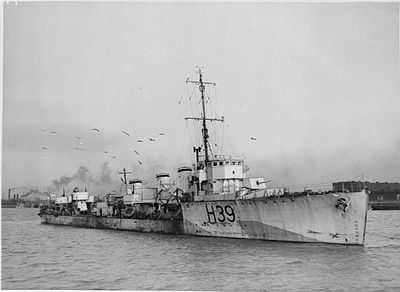
Background
On the basis of experience during World War I, the Admiralty instituted trade convoys in United Kingdom coastal waters from September 1939.[1] During the first year of the Battle of the Atlantic British convoy protection was the responsibility of the Western Approaches Command (WAC), based first in Plymouth, then, as the focus of the campaign moved after the Fall of France, in Liverpool.[2] The newest and most capable destroyers were assigned to screen capital ships of the Home Fleet; so, to augment the inadequate number of purpose-designed sloops, WAC was allocated a leftover array of limited production prototypes, ships built to foreign specifications, minesweepers, militarized yachts and fishing trawlers, and survivors of elderly destroyer classes no longer considered suitable for operation with the Home Fleet. These escorts were not numerous enough or sufficiently long ranged to accompany convoys across the Atlantic, but would screen convoys to and from meeting points thought to be beyond U-boat range defining the edge of the Western Approaches.
Convoy escorts were initially assigned on an ad hoc basis, dispatched as and when available, and arrived singly or in small groups. Command of the escort force fell to the senior officer present, and could change as each new ship arrived. Any tactical arrangements had to be made on the spot, and communicated by signal lamp to each ship in turn. The ships were unaccustomed to working together, and often had no common battle plan or tactics.
These deficiencies led to a major defeat in October 1940 when Convoy HX 79 from Halifax to Liverpool was attacked by a wolfpack of five U-boats remaining after an attack on convoy SC 7. Initially unprotected, a force of 11 warships were assembled but 12 ships in the convoy were sunk from attacks during the night while none of the U-boats were damaged.
The loss of ships from both SC 7 and HX 79 gave the impetus for Admiral Percy Noble, the commander-in-chief of WAC, to form discrete groups.[3] These Escort Groups often consisted of mixed types of small warships, but later were sometimes formed from a single class (e.g. the 1st, 3rd, 4th, 5th, 15th and 21st Escort Groups were composed entirely of Captain-class frigates when these ships became available to replace the older ships originally assigned to those groups.)[4]
Service history
In 1941 WAC had 8 escort groups formed.[3] These typically comprised four to eight ships, under the command of an RN officer, usually a Commander or Lieutenant Commander. By operating together under a single leader, groups were able to develop group tactics and practice their use; with the issue of a single short command the various ships of the group, often out of sight of each other, could be relied upon to act in a co-ordinated fashion. Later these tactics were standardized and taught to all escort group commanders at the Western Approaches Tactical Unit. In a ten-day period in 1941, four U-boats were sunk with the loss of three of Germany's top U-boat commanders.
This level of teamwork was never achieved by the attacking U-Boats. Although the wolfpack was co-ordinated in that a number of boats would be concentrated on a target convoy, once gathered the boats would attack individually without any attempt at further co-operation. It was not unknown for U-boats to get in each other's way whilst attacking, or collide with each other. Time and again during the Battle of the Atlantic relatively small, well-handled escort groups were able to frustrate attacks by more numerous groups of U-boats, and ensure the "safe and timely arrival" of their charges. In one example, in November 1942, Convoy ON 144 of 33 ships from Britain to North America protected by the Mid-Ocean Escort Force B6 of five Flower-class corvettes, was attacked by a group of ten U-boats. Over the next three days they fought off attacks by the wolfpack for the loss of five ships and one corvette; 28 ships arrived safely.[5][6] Following this action the Senior Officer Escort (SOE) - commander of the group - was "warmly congratulated" for preventing what could have been a major disaster,[6] and the contrast with HX 79 was apparent.
In practice, escort group cohesion was impaired by frequent changes of escort personnel and transferring ships between groups.[7] Personnel shuffling was inevitable as trained crewmen with combat experience were promoted and transferred to the expanding fleet of new ships.[8] Shuffling of ships from one escort group to another was often necessary to maintain escort group strength by replacing ships temporarily disabled by battle damage or the frequent machinery breakdowns of older warships.[9] The following list includes some duplication reflecting reassignments at the time of compilation. The original eight escort groups and the Canadian 14th through 25th escort groups were reorganized into the Mid-Ocean Escort Force (MOEF) in February and March 1942 with ships of the 9th Escort Group serving as leaders of MOEF groups B1 through B5. The ships of the earlier groups which had only a short range and were unsuitable for MOEF duty were reassigned to the Western Local Escort Force or duty with coastal convoys or the arctic convoys supplying the Soviet Union. The 36th through 44th escort groups remained relatively unchanged escorting convoys between Liverpool and Gibraltar and Sierra Leone.[10]
Organization
The following escort groups had been formed prior to United States Navy escort participation in the autumn of 1941:[11]
1st Escort Group

- Thornycroft type destroyer leader: HMS Keppel
- V and W-class destroyer: HMS Venomous
- Town-class destroyers: HMS Lincoln & Rockingham
- Admiralty S-class destroyers: HMS Sabre & Shikari
- Flower-class corvettes: HMS Alisma, Dianella, Kingcup & Sunflower
2nd Escort Group

- Admiralty type flotilla leader: HMS Douglas
- V and W-class destroyer: HMS Veteran
- Town-class destroyers: HMS Leamington & Sherwood
- Admiralty R-class destroyer: HMS Skate
- Admiralty S-class destroyer: HMS Saladin
- Flower-class corvettes: HMS Abelia, Anemone & Veronica
3rd Escort Group

- Thornycroft prototype destroyer: HMS Amazon
- Yarrow prototype destroyer: HMS Ambuscade
- B-class destroyer: HMS Bulldog
- Town-class destroyers: HMS Belmont & Georgetown
- Aubretia-class sloop: HMS Aubretia
- Flower-class corvettes: HMS Aconite, Heartsease, Renoncule, & Roselys
4th Escort Group
- B-class destroyers: HMS Beagle & Boadicea
- Town-class destroyers: HMS Montgomery, Roxborough & Salisbury
- Flower-class corvettes: HMS Commandant Détroyat, Heather, Lobelia, Narcissus, Orchis, & Snowdrop
5th Escort Group
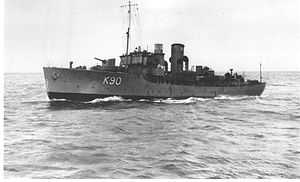
- V and W-class destroyers: HMS Vanoc, Volunteer & Walker
- Town-class destroyer: HMS Caldwell
- Flower-class corvettes: HMS Calendula, Campanula, Gentian, Honeysuckle, & Sweetbriar
6th Escort Group
- Thornycroft type destroyer leader: HMS Broke
- V and W-class destroyers: HMS Verity & Wolverine
- Town-class destroyers: HMS Buxton, Chelsea & Mansfield
- Flower-class corvettes: HMS Begonia, Camellia, Clematis, Columbine, Jasmine, & Larkspur
7th Escort Group
- V and W-class destroyers: HMS Westcott & Wanderer
- Town-class destroyers: HMS Campbeltown & St Albans
- Flower-class corvettes: HMS Acanthus, Eglantine, Gardenia, Hibiscus, Montbretia & Periwinkle
8th Escort Group
- Admiralty type flotilla leader: HMS Malcolm
- V and W-class destroyer: HMS Watchman
- Town-class destroyers: HMS Beverley & Newmarket
- Admiralty S-class destroyers: HMS Sardonyx & Scimitar
- Flower-class corvettes: HMS Arabis, Dahlia, Monkshood, Petunia, Violet & Verbena
9th Escort Group

10th Escort Group
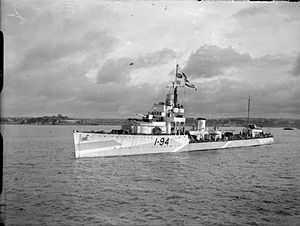
- V and W-class destroyers: HMS Vanquisher, Witch & Whitehall
11th Escort Group

- G and H-class destroyer: HMS Garland
- N-class destroyer: ORP Piorun
12th Escort Group
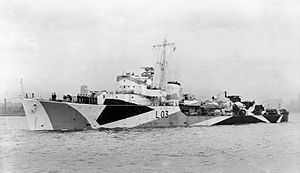
14th Escort Group

- C and D-class destroyers: HMCS Assiniboine & St. Laurent
- Brazilian destroyers: HMS Harvester & Havelock
- Town-class destroyer: HMS Ripley
15th Escort Group
- Canadian River-class destroyer: HMCS Saguenay
- Town-class destroyer: HMS Burwell
- Flower-class corvettes: HMS Dianthus, Honeysuckle & Snowberry
16th Escort Group
- Town-class destroyer: HMS Broadwater
- Flower-class corvettes: HMCS Chilliwack, Rimouski & Spikenard
17th Escort Group
- Town-class destroyer: HMS Broadway
- Flower-class corvettes: HMS Polyanthus, Cobalt & Trail
18th Escort Group
- Town-class destroyer: HMS Churchill
- Flower-class corvettes: HMS Camellia, Arrowhead & Eyebright
19th Escort Group
- Town-class destroyer: HMS Burnham
- Flower-class corvettes: HMCS Mayflower, Agassiz & Lévis
20th Escort Group
- Town-class destroyer: HMCS Columbia
- Flower-class corvettes: HMS Gladiolus, Mimosa & Wetaskiwin
21st Escort Group
- Town-class destroyer: HMCS St. Croix
- Flower-class corvettes: HMCS Chambly, Pictou, Buctouche & Galt
22nd Escort Group
- Town-class destroyer: HMS Ramsey
- Flower-class corvettes: HMS Candytuft, Bittersweet & Fennel
23rd Escort Group
- Town-class destroyers: HMS Chesterfield & Reading
- Flower-class corvettes: HMCS Hepatica & Prescott
24th Escort Group
- Canadian River-class destroyer: HMCS Skeena
- Flower-class corvettes: HMCS Alberni, Orillia & Kenogami
25th Escort Group
- Town-class destroyer: HMCS Niagara
- Flower-class corvettes: HMS Alysse, Celandine & Collingwood
36th Escort Group
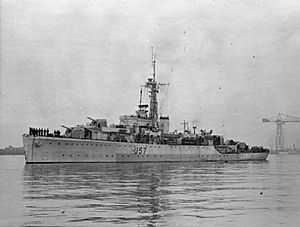
- Bittern-class sloop: HMS Stork
- Grimsby-class sloop: HMS Deptford
- Flower-class corvettes: HMS Arbutus, Cowslip, Convolvulus, Marigold, Pentstemon, Rhododendron, Samphire & Vetch
37th Escort Group

- Black Swan-class sloop: HMS Black Swan
- Shoreham-class sloop: HMS Fowey
- Flower-class corvettes: HMS Bluebell, Campion, Carnation, Heliotrope, La Malouine, Mallow, Myosotis & Stonecrop
40th Escort Group

- Town-class destroyer: HMS Stanley
- Shoreham-class sloop: HMS Bideford
- Banff-class sloops: HMS Culver, Gorleston, Landguard & Lulworth
41st Escort Group
- Town-class destroyer: HMS Clare
- Black Swan-class sloop: HMS Ibis
- Bittern-class sloop: HMS Enchantress
- Grimsby-class sloop: HMS Aberdeen
- Banff-class sloops: HMS Hartland & Walney
42nd Escort Group
- Shoreham-class sloop: HMS Weston
- Hastings-class sloop: HMS Folkestone
- Grimsby-class sloops: HMS Londonderry & Wellington
- Banff-class sloops: HMS Sennen & Totland
43rd Escort Group
- Town-class destroyer: HMS Newport
- Shoreham-class sloop: HMS Rochester
- Hastings-class sloop: HMS Hastings
- Bridgewater-class sloop: HMS Sandwich
- Grimsby-class sloops: HMS Leith
- Armed yacht: HMS Philante
44th Escort Group
- Town-class destroyer: HMS Bradford
- Egret-class sloop: HMS Egret
- Hastings-class sloop: HMS Scarborough
- Grimsby-class sloop: HMS Fleetwood
- Banff-class sloops: HMS Banff & Fishguard
See also
- Mid-Ocean Escort Force
- Escort Group B2
- Escort Group B6
- Escort Group B7
- 5th Escort Group
- 36th Escort Group
- Hunter-killer Group
References
Citations
- ↑ Hague 2000 p.23
- ↑ Roskill 1954, p. 00.
- ↑ 3.0 3.1 Elliott 1977, p. 59
- ↑ Collingwood 1998, p. 00.
- ↑ Blair 1996, p. 118.
- ↑ 6.0 6.1 Blair 1996, p. 119
- ↑ Milner, p.192
- ↑ Milner, p.56
- ↑ Milner, p.98
- ↑ Mason, Geoffrey B. "HMS Malcolm (D 19) - Scott-class Flotilla Leader". Service Histories of Royal Navy Warships in World War 2. edited by Gordon Smith. naval-history.net. Retrieved 18 January 2014.
- ↑ Rohwer & Hummelchen, pp.83 & 89
Bibliography
- Blair, C. Hitler's U-Boat War: The Hunters 1939-1942 (Volume 1):. W&N, 1996. ISBN 0-304-35260-8.
- Collingwood, D, J. The Captain Class Frigates in the Second World War: An Operational History of the American Built Destroyer Escorts Serving Under the White Ensign from 1943-46. Pen & Sword Books Ltd, 1998. ISBN 0-85052-615-9.
- Elliott, P. Allied Escort Ships of World War II . Macdonald & J, 1977. ISBN 1-84037-141-2.
- Hague, Arnold (2000). The Allied Convoy System 1939–1945. Naval Institute Press. ISBN 1-55750-019-3.
- Milner, Marc (1985). North Atlantic Run. Naval Institute Press. ISBN 0-87021-450-0.
- Rohwer, J. and Hummelchen, G. (1992). Chronology of the War at Sea 1939–1945. Naval Institute Press. ISBN 1-55750-105-X.
- Roskill, S. The War at Sea 1939-1945 Vol I. 1954.